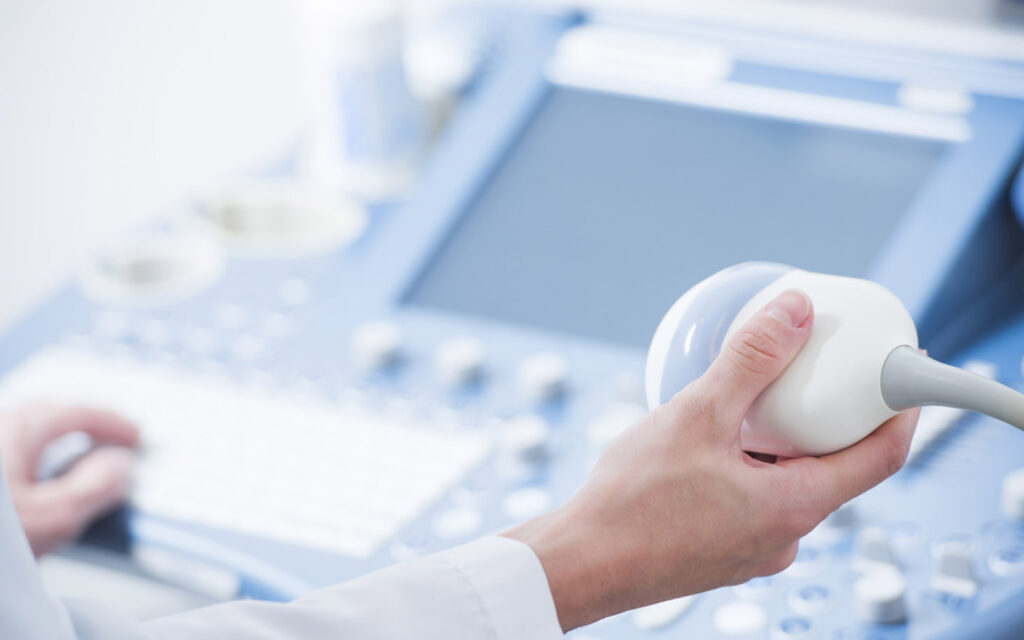Does ultrasound provide a definitive diagnosis?
Ultrasound is a powerful diagnostic tool, and in many instances the only one necessary to yield the diagnosis – but, unfortunately, not all cases fall into this category. Ultrasound permits detailed evaluation of the internal organ structure – for one, it is the only available imaging modality to assess layering of the small intestinal wall. It can identify the most minute changes, but in many instances these changes are not specific to a single disease process, as different conditions overlap in their effects on various tissues. It is often not possible to predict how definitive an ultrasound will be prior to performing one. For example, for a dog with increased kidney bloodwork values ultrasound may show: kidney stones or occlusion of a ureter (definitive diagnosis); changes associated with prior injury, degeneration and remodeling (diagnosis of chronic disease without revealing the underlying cause); evidence of ongoing inflammation (semi-definitive, as a variety of infectious and non-infectious diseases fall under this broad umbrella, necessitating further testing); or no detectable changes at all, as with certain other inflammatory and auto-immune conditions of the kidneys. Certainly, in the first instance the ultrasound is far more rewarding than in the last! But in every case, it narrows the list of possibilities the ordering clinician needs to consider, further advancing the diagnostic process.
What areas of the body can be imaged using ultrasound?
While ultrasound of the abdomen is by far the most common application, the imaging technique can be applied to other areas of the body, but its limitations have to be taken into account. The image is generated by the ultrasound probe sending out very brief sound wave pulses and “listening” for echoes as the sound bounces off the tissues. These bursts have much higher frequency than any animal can hear (even bats, who use echolocation in a similar manner). The sound waves travel well in water and soft tissues, but have very poor penetration of tissue-gas and tissue-mineral interfaces. This prevents imaging of any gas-filled (e.g. lung) or mineral (e.g. bone) regions of the body, or anything “beyond” them from the perspective of the ultrasound probe – even a small collection of gas in the path of the sound waves prevents them from reaching deeper tissues. Consequently, the abdomen, consisting predominantly of various organs and surrounding soft tissues, is a region well-suited for ultrasound, while the head, protected by skull, or chest, normally air-filled, are far from ideal. Still, both of these areas can and are imaged when deviation from norm due to disease or other circumstances makes them more accessible: a chest mass becomes visible to the sonographer if it extends to the lung periphery; brain may be imaged in young puppies through the gaps in the yet-unfused skull. It is also possible to perform ultrasound of the soft tissues of the limbs. However, various muscles and tendons have similar composition and subsequently appear very similar on ultrasound, requiring experience and advanced knowledge of anatomy for interpretation.
Why does my pet need to be fasted prior to ultrasound?
As discussed above, ultrasound pulses cannot advance through collections of gas; they also struggle with structures that are more dense than soft tissues, such as kibble. Consequently, a stomach after a meal, full of gas and food, becomes an impenetrable imaging obstacle. Especially in dogs, the stomach is a highly distensible organ, which can block visualization of many structures located further toward the back of the pet, e.g., liver, adrenal glands and major vessels. During active digestion gas is common throughout the small intestine, further obscuring the view of the mid-abdomen. Additionally, the process of nutrient absorption can alter the appearance of the small intestinal wall, complicating diagnosis of underlying pathology. As a bonus, the ability of the gastrointestinal tract to move ingested material through in a predictable fashion during a predetermined period of fasting provides valuable diagnostic information about its functionality. For this reason, preventing food intake by the pet for at least 8 hours prior to ultrasound (or longer, depending on the case) is recommended to permit a thorough and high-quality study.
Why are pets often shaved for ultrasound?
This is also done to avoid interference from gas-tissue interfaces, as air gets trapped among the hair follicles. Many sonographers find they maximize image quality and achieve the highest level of detail by shaving the region of interest and covering it in a layer of ultrasound gel, which further reduces any gas bubbles between the ultrasound probe and the skin. Some sonographers find that they are able to achieve this by thoroughly wetting the fur without shaving. Both methods have merits, and, while different sonographers may use different imaging techniques (this includes not only shaving, but also pet positioning), individual consistency is key to effective imaging.
Why may sedation be needed for ultrasound?
This depends on a variety of factors, many of which are pet-related – temperament, proclivity for panting, size – as well as the target area and aim of the ultrasound study. The need to sedate a pet for the study does not mean they are poorly behaved! But being placed on their back for a significant period of time is a strange experience for a lot of pets, and in this puzzling position many understandably respond by trying to wiggle away or tensing up. Motion, panting and flexion of the abdominal muscles are all detrimental to the ultrasound quality, and while some pets respond well to a quiet environment, soothing voice, and gentle touch of the handlers, for others this does not suffice. In these cases, sedation may be needed to provide relaxation, as well as ease any discomfort caused by the pressure of the ultrasound probe. The latter can be particularly important for patients experiencing abdominal pain, who benefit greatly from the concurrent analgesic effects. While the additional costs and individual risks of sedation always need to be considered, it can be a great option to reduce the duration and stress of the study, while also improving its quality with the ultimate goal of diagnostic efficiency and effectiveness.



